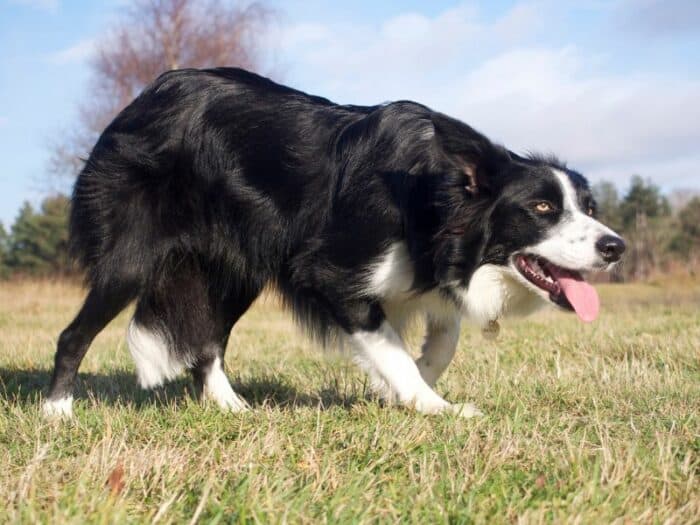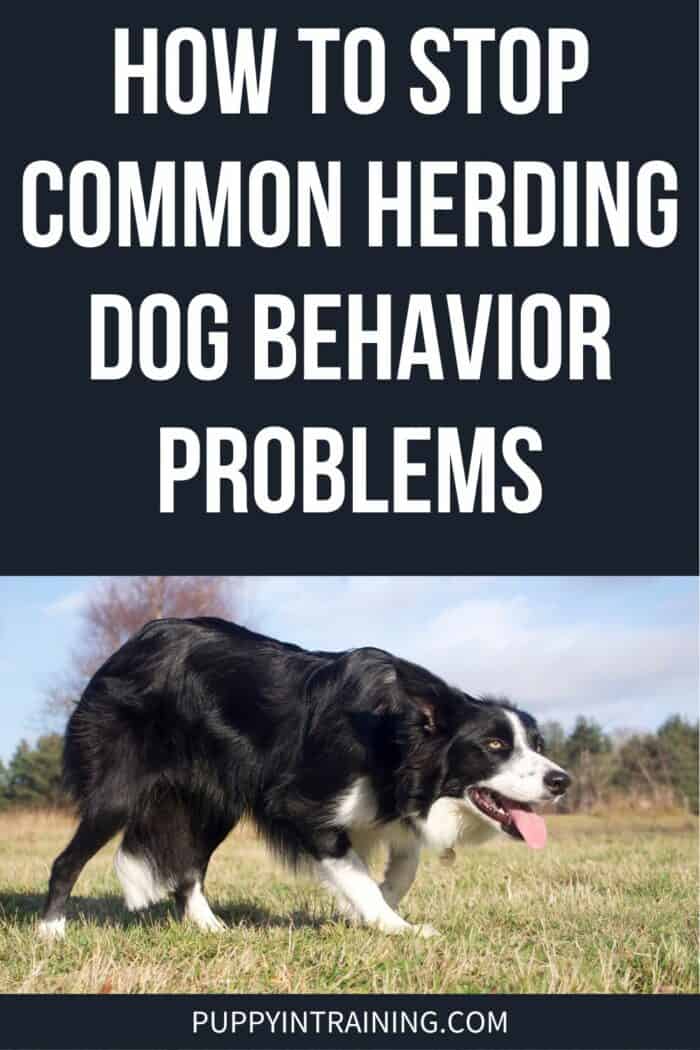This post may contain affiliate links. We may earn money or products from the companies mentioned in this post.
If you have recently brought a herding dog into your family, welcome to the club!
These amazing dogs are driven, intelligent, and bred to work closely with people.
As a result, they often bond closely with their family, making for very loyal companions. But life with a herding dog isn’t all sunshine and roses.
They are highly active dogs that need a lot of exercise and stimulation. If those needs aren’t met, it can lead to common herding dog behavior problems.
What is dog herding behavior, and how can it be problematic?
How can you keep your dog happy, healthy, and free from these behavioral struggles?
As a herding dog owner, the best thing you can do is familiarize yourself with the reason for these behaviors and how to meet your dog’s needs daily.
To help you incorporate these needs into your daily routine, I will share some common herding dog behavior traits, why your dog may be acting this way and a list of my favorite herding dog games.

What is a Herding Dog?
Herding dogs were bred to gather, herd, and protect livestock. When working in the field, they don’t always have a person beside them to dictate their next move.
For this reason, they are independent, intelligent, and athletic. They rely heavily on their instincts to carry out their jobs.
Originally the Herding Group was part of the Working Group of dogs.
However, recognizing these breeds’ unique traits and characteristics, the Herding Group was established as a separate breed class in 1983.
While the Herding Group is relatively large with some interesting and unique breeds, it also includes some very popular and common dog breeds such as:
As I hinted at already, I share my heart and home with a couple of herding dogs.
Our oldest girl Daviana is a German Shepherd mix.
Although she is a mix, her personality has always been heavy on the German Shepherd traits.
Recently, we brought Lucifer, a German Shepherd/Australian Cattle Dog, into the mix.
I adore these furry balls of energy, but they are not the right fit for every home!
This is why those considering adopting a dog need to research the different breeds they are considering.
What are the Personality Traits of a Herding Dog?
The breeds above vary considerably in size and appearance, but they all have similar personality traits.
These skills allowed herding dogs to perform best in their given task.
But these same aspects of their personality can lead to trouble in a home environment if you aren’t prepared for it.
Energetic and Athletic
If you plan on owning a herding dog, you need to be prepared to provide them with plenty of daily exercise.
They are driven, athletic, and energetic pups bred to keep up with working a full day outdoors with livestock.
A short daily walk isn’t enough to meet their needs, and too much pent-up energy often leads to behavioral issues.
Focused and Intelligent
In addition to physical exercise, herding dogs require a lot of mental stimulation. They are highly intelligent dogs, and you must make their brains work.
You can meet this need in several ways, including training sessions, food puzzles, and interactive toys.
If your dog is bored, they are more likely to resort to unwanted behaviors.
Loyal
Another result of their herding past, herding dogs were bred to work closely with people.
Many herding dogs aren’t big on strangers but bond closely with their families.
They are great companions (as long as their needs are met). But they can become protective of their people.
What Does Herding Behavior Look Like?
We can’t talk about temperament and herding dog behavior problems without addressing the most prominent issue – herding.
What exactly IS herding dog behavior, and why is it frowned upon in a home environment?
Bred to round up and direct the movement of livestock, herding dogs had an important job in keeping the farm animals safe.
But they didn’t always have people there to direct their every move. They learned to rely on their instinct to work independently and keep the herd safe.
Today, herding breeds still have this instinctual behavior to “herd” or move livestock.
While you may not have cattle or sheep around for your dog to focus on, these behaviors often manifest with young children, other pets (like cats), or even adults.
Some examples of herding dog behavior include:
- Nipping at your heels
- Circling you or their belongings
- Chasing
- Stalking
- Eyeing (or staring at you intensely)
Obviously, a dog that nips at or chases your children is far from an ideal situation. There is no way to remove these traits from your dog altogether.
They will always have them. But you can manage your dog’s behavior with training and lifestyle changes.
This includes never leaving children with your dog unsupervised (which is a good rule for all dogs).
Colby’s Aussie mix, Linus used to herd his nieces and nephews. Linus’ preferred method of herding was to nip at the heels.
How to Stop Common Herding Dog Behavior Problems
When training your dog, the most important thing to remember is that herding dogs were bred for a purpose.
If you are struggling with herding dog behavior problems, be patient. They aren’t doing this just out of spite. Their herding instincts are a part of their biological makeup.
This means that simply punishing your dog for demonstrating herding behaviors won’t resolve the situation.
There is some good news for dog owners interested in learning how to train herding dogs.
Much of the training needed to address and manage these behaviors is the same training that you already see discussed in terms of basic obedience.
This includes commands like “leave it” or “look” to redirect your dog’s attention away from the object or person they fixate on and back to you.
In addition to teaching these forms of redirection, you will need to be aware of your surroundings and ready to respond quickly to stop your dog in their tracks.
Herding dogs aren’t drawn to the vision of a cow or a sheep. Instead, their instincts are triggered by movement.
This could be a child running, a vehicle driving past or a biker on your favorite walking path.
When you recognize a movement that may tap into those instincts, be prepared to act accordingly.
Another excellent option for working towards long-term management is to teach your dog self-control.
This means teaching your dog to stay calm when faced with a trigger or excitement.
One of the best ways to teach self-control is to ask your dog to sit or lay and stay. After the stay command has been given, toss a ball or treat.
The goal is for your dog to wait until you release them to enjoy their reward.
7 Activities or Games for Herding Dogs
In addition to training your dog and managing their environment, you will need to provide daily physical and mental enrichment.
Each day I schedule time to play with the pups, and not just for my enjoyment. Playtime allows you to provide enrichment and a stronger bond with your dog.
Here are a few games and activities to help you get started!
1. Enjoy a Fun Training Session
Training may not be the first thing that comes to mind when considering games, but training time can be fun!
Herding dogs are workaholics and thrive when given a job or a task. This is a great way to challenge their mind while appealing to their desire to work.
Try incorporating a fun new trick if you find training monotonous or boring.
For example, my boy Lucifer has been working on learning to pick up his toys and put them away in the toy box.
2. Play a Game of Fetch or Tug
Both fetch and tug are staples when it comes to playing with your dog, and for a good reason.
On the surface, they may not look like much. But they offer both physical and mental exercise.
As a bonus, both games can help to work on your dog’s self-control and restraint.
When you ask your dog to drop the ball or let go of the tug toy, you challenge them to disengage from something they are focused on.
This is a skill that will help with managing their herding behaviors.
3. Go for a Hike
Hikes are a great opportunity to burn some energy for an active dog. While navigating your local trail, allow your dog to explore their environment.
There are many great smells that will provide mental stimulation, helping to wear out even the most active dogs.
4. Try Scent Training
Scent work challenges your dog to use their nose to seek out different odors.
This is a great way to challenge your dog’s mind on a rainy day, as it doesn’t require going outdoors.
There are scent work kits that you can pick up to get started or stick to the basics by simply hiding your dog’s favorite treats and asking him to search for them.
5. Play a Game of Hide and Seek
One of my favorite herding dog games, hide and seek is a fun way for your kids to play with your dog in a safe and controlled manner.
Ask your dog to sit and stay in one location.
If they are still learning the stay command, you may need someone there to supervise the dog and keep them in place until you’re ready.
Find a hiding space that is out of your dog’s line of sight or in another room.
If you have younger kids, bring them with you to hide. Older kids can even find their own separate hiding spots.
When you’re ready, call your dog and watch as they use their sense of smell to find you. Stay quiet while they look so you don’t give yourself away!
When your dog does find you, reward them with praise or a treat reward.
6. Introduce Puzzle Games and Interactive Toys
There may be times throughout the day when you need to keep your herding dog occupied and entertained while you are busy.
As someone who works from home, this is a challenge that I am faced with quite often.
So, how do I keep the pups from interrupting Zoom calls or preventing me from completing my work?
Interactive toys like food puzzles, treat dispensers or toys that involve multiple pieces are the secret to success.
We feed all our meals in food puzzles and slow feeders to turn each meal into a mental enrichment opportunity.
Additionally, we have stuffed Kongs and West Paw Toppls and lick mats in the freezer, ready for the moments when I need to keep them entertained.
They hold our dogs’ attention well, and our pups are usually ready for a nap when they are finished.
7. Try a Herding Ball
One way to address herding dog behavior problems is to provide them with a safe outlet for these instincts.
A herding ball is a ball that is too large for your dog to pick it up or carry around. Instead, they move it around by pushing it, nipping at it, and chasing it, aka “herding it.”
Let your dog play with the herding ball freely or incorporate it into a structured sport.
Treibball, also known as “urban herding,” involves moving the balls with a set goal, such as moving them in a particular order or to a designated location.
Final Thoughts
Herding dogs can make incredible companions in the right home environment but require a more active lifestyle.
Don’t ignore your dog’s natural instincts. Instead, find ways for them to use these herding behaviors in a safe, controlled way.
And always remember the old saying, a tired dog is a good dog!
What about you?
Do you have a herding dog?
What do you do with your herding dog to keep him out of mischief?
Tells us about your experiences in the comment section below.
Save To Pinterest

Top Picks For Our Puppies
- BEST PUPPY TOY
We Like: Calmeroos Puppy Toy w/ Heartbeat and Heat Packs – Perfect for new puppies. Helps ease anxiety in their new home. - BEST DOG CHEW
We Like: Mighty Paw Naturals Bully Sticks – All of our puppies love to bite, nip, and chew. We love using Bully Sticks to help divert these unwanted behaviors. - BEST DOG TREATS
We Like: Crazy Dog Train-Me Treats – We use these as our high-value treats for our guide dog puppies. - BEST FRESH DOG FOOD
We Like: The Farmer’s Dog – A couple months ago we started feeding Raven fresh dog food and she loves it! Get 50% off your first order of The Farmer’s Dog.
Check out more of our favorites on our New Puppy Checklist.


